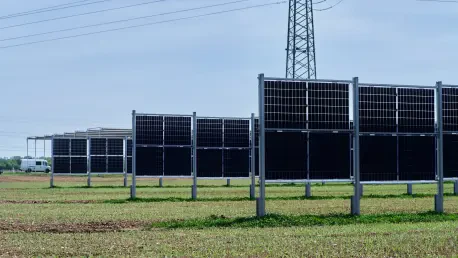As the solar and Battery Energy Storage Systems (BESS) industries continue to expand, they navigate a complex landscape marked by both technological innovation and market opportunities. However, alongside these advancements, community resistance presents a significant hurdle. Concerns around environmental impacts and aesthetic changes fuel apprehension among local residents, prompting developers to innovate engagement strategies and optimize supply chain and asset management. This exploration uncovers the strategies being utilized by developers to engage communities effectively, highlighting the mitigation of supply chain risks and optimizing BESS for market success.
Embracing Community Engagement
Addressing Local Concerns
Community apprehension regarding solar projects often arises from potential environmental disruptions and aesthetic alterations to landscapes. To address these concerns, developers are adopting a proactive approach that aligns projects with community values, fostering local support by prioritizing ecological and aesthetic considerations. By ensuring transparency and communication from the planning stages, developers can build trust and demonstrate commitment to minimal environmental impact. Addressing such concerns requires comprehensive planning that takes into account local geographical and social contexts, thereby reducing apprehension and resistance from residents.
Engaging with local communities involves identifying shared objectives and collaborating to integrate these values into the project design. Developers are increasingly recognizing the necessity of incorporating environmental safeguards and aesthetic enhancements, ensuring the project’s alignment with community aspirations. By embedding these considerations into the project, local support is bolstered, promoting sustainable development. Moreover, adapting designs to complement existing landscapes and addressing ecological concerns can transform potential opposition into advocacy, paving the way for smoother project implementation and fostering mutual understanding.
Innovative Engagement Strategies
Developers in regions such as the US and UK are pioneering inventive community engagement initiatives to mitigate opposition and enhance cooperation. These strategies include the establishment of solar farms on reclaimed lands, highlighting their dedication to environmental rejuvenation and demonstrating an alignment with community goals. Biodiversity projects are another facet of these initiatives, integrating environmental sustainability practices into project plans and showcasing a commitment to ecological preservation. Through collaborative partnerships, developers aim to reduce barriers and foster collaboration, creating mutually beneficial outcomes for communities and companies alike.
The implementation of these integrated strategies not only addresses existing opposition but also promotes community involvement in the project’s lifecycle. Developers are expanding beyond traditional engagement methods by involving local citizens in decision-making processes and incorporating community feedback, enhancing transparency and accountability. By investing in educational and outreach programs, developers empower community members, equipping them with knowledge and influence over the project’s trajectory. Such inclusive participation not only improves community relations but serves to enhance the project’s credibility and acceptance, ensuring its sustainability and long-term success in the region.
Mitigating Supply Chain Risks
Importance of Quality Assurance
In the rapidly evolving BESS sector, ensuring robust supply chains is indispensable given the intricacies of manufacturing processes. Effective quality assurance procedures are crucial in minimizing operational disruptions and sustaining the reliability and performance of BESS assets. Consistent application of quality metrics is essential to identify potential vulnerabilities within the supply chain and address them proactively. By adhering to strict quality standards, manufacturers can ensure the integrity and functionality of components from production to deployment, safeguarding against unforeseen supply interruptions.
The implementation of rigorous quality assurance practices not only fortifies supply chain resilience but also promotes long-term operational stability. Developers prioritize quality inspection and control measures at various stages, from raw material procurement to final assembly, establishing a comprehensive framework for quality management. This proactive approach reduces the likelihood of malfunctions and operational failures, enhancing confidence in BESS solutions among stakeholders. Emphasizing quality assurance as a cornerstone of supply chain management becomes vital for sustaining growth and strengthening credibility within an increasingly competitive market.
Risk Mitigation Techniques
Mitigating supply chain risks in the BESS industry necessitates detailed assessment and proactive planning to bolster resilience against disruptions. Experts advocate for employing an array of risk management strategies, including a thorough examination of potential vulnerabilities and developing contingency plans tailored to specific scenarios. By adopting strategic approaches, such as diversifying suppliers and embracing technological innovations, companies can enhance agility and adaptability, safeguarding operations against unexpected disturbances. Building robust communication networks within the supply chain further ensures that critical information is exchanged promptly, reducing response times during crises.
Central to effective risk mitigation is the establishment of integrated supply chain systems capable of anticipating and responding to evolving market conditions. By investing in advanced forecasting techniques and analytical tools, developers can optimize operations, streamline distribution channels, and enhance supply chain efficiency. Comprehensive risk mitigation not only secures operational stability but positions BESS developers favorably within the industry, allowing them to capitalize on growth opportunities and maintain performance under fluctuating market dynamics. Ensuring robust risk management frameworks is pivotal to achieving sustained success and navigating a complex and unpredictable industry landscape.
Strategies for Market Competitiveness
Smart Forecasting and Optimization
Navigating competitive energy markets demands adept forecasting and real-time optimization strategies to maximize financial returns. Operators focus on deploying sophisticated bidding techniques to position themselves advantageously amid volatile conditions. Critical to achieving financial success is the ability to anticipate market fluctuations and respond promptly with informed strategies that harness predictive analytics. By leveraging smart forecasting, operators can optimize their asset utilization and align operations with market demand, enhancing both profitability and sustainability.
Real-time optimization influences multiple facets of the energy markets, enabling operators to adapt swiftly to changing conditions and capitalize on growth opportunities. Implementing advanced software solutions that monitor real-time data empowers operators with insights into market trends, helping refine strategies for bidding and energy storage deployment. Smart optimization fosters operational efficiency and allows for precision in asset management, ensuring operators can navigate uncertainties confidently and maximize their returns on investments. In an industry characterized by rapid technological evolution and competitive pressures, smart forecasting stands as a vital tool for securing competitive advantage and achieving sustained growth.
Revenue Maximization in Evolving Markets
As the solar and Battery Energy Storage Systems (BESS) sectors flourish, they are traversing a complex terrain filled with technological advancements and promising market prospects. Despite these innovations, they face substantial community resistance. Local residents are anxious about environmental impacts and changes to their surroundings, posing significant challenges for developers. To counter this, developers are crafting effective community engagement strategies while also enhancing supply chain and asset management operations. By doing so, they address local concerns, mitigate risks related to supply chains, and optimize BESS for greater market success. This exploration sheds light on how developers are refining their approaches to engage communities, emphasizing the importance of balancing progress with public opinion. They strive to foster better relationships with stakeholders to ensure the smooth implementation of these technologies, thereby maximizing the benefits for both the industry and the community.









